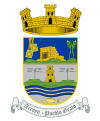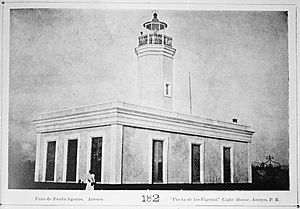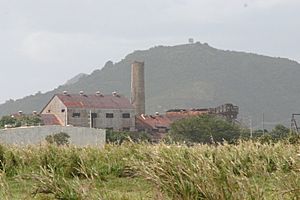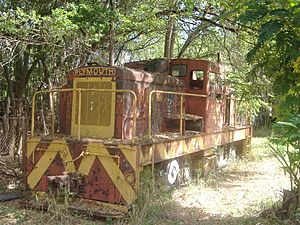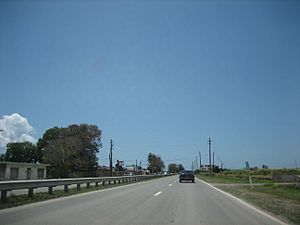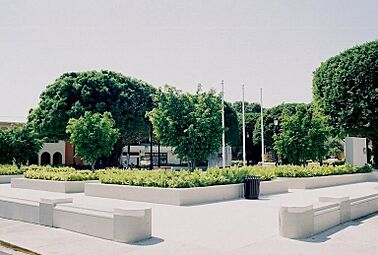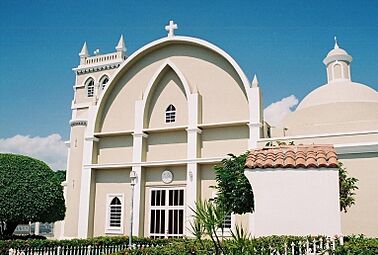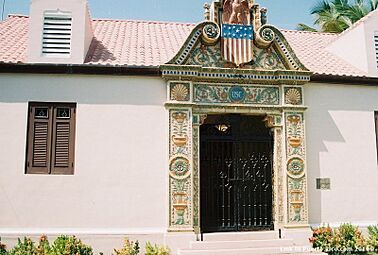Arroyo, Puerto Rico facts for kids
Quick facts for kids
Arroyo
Municipio Autónomo de Arroyo
|
|||
|---|---|---|---|
|
Town and Municipality
|
|||
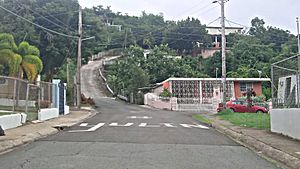
Street in Barrio Palmas in Arroyo
|
|||
|
|||
| Nicknames:
"Pueblo Grato" "Los Bucaneros" |
|||
| Anthem: "Arroyo" | |||

Map of Puerto Rico highlighting Arroyo Municipality
|
|||
| Sovereign state | |||
| Commonwealth | |||
| Settled | early 19th century | ||
| Founded | December 25, 1855 | ||
| Founded by | Ignacio de Orbeta | ||
| Barrios | |||
| Area | |||
| • Total | 23.0 sq mi (59.6 km2) | ||
| • Land | 15 sq mi (39 km2) | ||
| • Water | 8.0 sq mi (20.6 km2) | ||
| Population
(2020)
|
|||
| • Total | 15,843 | ||
| • Rank | 67th in Puerto Rico | ||
| • Density | 688.5/sq mi (265.82/km2) | ||
| Demonym(s) | Arroyanos | ||
| Time zone | UTC−4 (AST) | ||
| ZIP Code |
00714
|
||
| Area code(s) | 787/939 | ||
| Major routes | |||
Arroyo is a charming town and municipality located on the southern coast of Puerto Rico. It sits right next to the Caribbean Sea. To its east is the municipality of Guayama, and to its northwest is Patillas. Arroyo is divided into six main areas called barrios, including the downtown area, which is its administrative center.
Contents
What's in a Name?
The Meaning of Arroyo
The name Arroyo means "creek" or "brook" in English. People believe the town got its name from a small stream. Travelers would stop there to cool off before continuing their journey.
Town Nicknames
Arroyo has a few interesting nicknames. One older nickname was Pueblo Ingrato, meaning "Ungrateful Town." This name came from a sad legend in the 1800s. It was said that locals treated a generous resident badly when he got sick.
However, in more recent times, people have worked to change this nickname to Pueblo Grato, which means "Grateful Town." This new name better reflects the town's friendly and relaxed vibe today.
Residents of Arroyo are also often called Bucaneros, or "Buccaneers." This nickname refers to the area's history with pirates and buccaneers. Even the local sports teams, like the volleyball team, are called Los Bucaneros!
A Look Back in Time
Founding of Arroyo
The town of Arroyo was officially founded on December 25, 1855. However, some historians think people lived in the area even before the Spanish arrived in Puerto Rico. There are different stories about how the town started. One story says it began when people from the nearby town of Guayama came looking for a port to trade goods.
Between 1859 and 1860, the local government made plans to build streets, a town square, and a sewer system.
Samuel Morse's Telegraph
In 1858, Samuel Morse, the inventor of the telegraph, brought wired communication to Latin America. He set up a telegraph system in Puerto Rico. Morse's daughter, Susan, often visited her uncle in Guayama. She later married Edward Lind, a merchant who owned a farm called Hacienda La Henriqueta in Arroyo.
Morse often spent winters at the farm with his daughter and son-in-law. He set up a two-mile telegraph line connecting the farm to their house in Arroyo. This line was opened on March 1, 1859. It was a big moment for communication in the region.
Arroyo in the 20th Century
After the Spanish–American War, Spain gave Puerto Rico to the United States in 1898. In 1899, a census showed that Arroyo had a population of 4,867 people.
In 1902, a law tried to combine Arroyo with Guayama. But this law was changed in 1905, and Arroyo became its own municipality again.
In 1999, the U.S. Congress recognized Arroyo's 100-year relationship with the U.S. They noted that many citizens from Arroyo had served and died in wars for the United States.
Hurricane Maria's Impact
On September 20, 2017, Hurricane Maria hit Arroyo hard. The strong winds and heavy rain caused many landslides. About 1,550 buildings in Arroyo were damaged or destroyed. A bridge on Highway PR-725 collapsed, leaving 130 families cut off.
Exploring Arroyo's Geography
Land and Water
Arroyo is part of a flat area known as the Southern Coastal Valley. This region is usually very dry. However, its plains are good for farming because of artificial irrigation systems.
The Nigua River flows through Arroyo from north to south. Many smaller rivers also contribute to its water system. There is even a natural mineral water spring in Virella Colony.
Barrios of Arroyo
Like all municipalities in Puerto Rico, Arroyo is divided into smaller areas called barrios. The main town area, with its municipal buildings, central square, and a large Catholic church, is called "el pueblo".
The barrios of Arroyo are:
Special Communities
Some communities in Puerto Rico are called Comunidades Especiales (Special Communities). These are areas where people might face challenges or social exclusion. In Arroyo, some of these communities include the Marín neighborhood, parts of Palmas barrio, Yaurel barrio, and the San Felipe-Arizona zone.
Population Changes
| Historical population | |||
|---|---|---|---|
| Census | Pop. | %± | |
| 1900 | 4,867 | — | |
| 1910 | 6,940 | 42.6% | |
| 1920 | 7,074 | 1.9% | |
| 1930 | 8,199 | 15.9% | |
| 1940 | 10,746 | 31.1% | |
| 1950 | 12,936 | 20.4% | |
| 1960 | 13,315 | 2.9% | |
| 1970 | 13,033 | −2.1% | |
| 1980 | 17,014 | 30.5% | |
| 1990 | 18,910 | 11.1% | |
| 2000 | 19,117 | 1.1% | |
| 2010 | 19,575 | 2.4% | |
| 2020 | 15,843 | −19.1% | |
| U.S. Decennial Census 1899 (shown as 1900) 1910-1930 1930-1950 1960-2000 2010 2020 |
|||
Fun Things to Do
Tourist Attractions
Arroyo is home to eight beautiful beaches. There are also several interesting places to visit:
- The Enrique Huyke Monument, honoring a famous educator and athlete.
- The Samuel Morse Monument, dedicated to the inventor of the telegraph.
- Casa de Aduana, a historic building that is now a museum.
Other popular spots include Hacienda La Cora, Las Palmas Beach, Punta Guilarte, the Punta de Las Figuras Lighthouse, and the historic Arroyo Sugar Cane Train.
In 2021, the Puerto Rico Tourism Company started a "Voy Turistiendo" (I'm Touring) campaign. It encouraged local tourism. For Arroyo, the campaign highlighted the Malecón Paseo Las Américas (a boardwalk), Centro Vacacional Punta Guilarte (a vacation center), Faro Punta Figuras (the lighthouse), and the Arroyo Surfing Park.
Culture and Events
Festivals and Celebrations
Arroyo loves to celebrate!
- The town holds its patron saint festival in July. This celebration, called Fiestas Patronales de Nuestra Sra. del Carmen, honors Our Lady of Mount Carmel. It usually includes parades, games, local crafts, rides, delicious food, and live music.
- A traditional carnaval takes place in February.
- The Fiesta Negra in March celebrates the island's African heritage.
- The Festival del Pescao (Fish Festival) is celebrated in November.
Sports in Arroyo
While Arroyo doesn't have professional sports teams, it has several amateur teams. These teams compete in the Class A category, especially in baseball.
Arts and Entertainment
The Museo Antigua Aduana is a historic building that now displays art by local artists. In 2011, the Cine Renacimiento (Renaissance Cinema), which first opened in 1922, was renovated. It is now a modern theater space called Teatro Renacimiento (Renaissance Theater).
Economy of Arroyo
In the past, Arroyo was famous for producing sugar. The Central Lafayette was a major sugar mill in the area.
Today, Arroyo's economy is more focused on manufacturing and pharmaceutical industries. For example, Stryker Corporation, a company that makes medical implants and surgical equipment, has a production plant in the town.
Symbols of Arroyo
Flag
Arroyo has an official flag. It has two equal horizontal stripes. The top stripe is orange, and the bottom one is black. In the center of the flag is Arroyo's coat of arms.
Coat of Arms
The coat of arms is divided into two parts.
- The top part shows a church in a blue background, with a rosary on the right and a flower on the left.
- The bottom part features two silver telegraph poles on green hills. Below them are wavy blue and silver stripes, with a fish underneath.
Above the shield is a crown with three purple towers. Below the shield, a banner proudly displays the motto, Arroyo Pueblo Grato.
Education in Arroyo
The Puerto Rico Department of Education manages schools in Arroyo. The town has seven elementary schools, three junior high schools, and one high school.
Getting Around
In the past, when the sugarcane industry was booming, Arroyo was part of the island's railroad system. Trains would carry sugar to other towns. A small part of this train line was recently used for tourism, known as the Tren del Sur.
To reach Arroyo, visitors typically use Puerto Rico Highway 3. There are also other local roads that connect to the municipality. Arroyo has 13 bridges.
Famous People from Arroyo
- Carmen Bozello y Guzmán: A playwright from the 1800s.
- Juan Bernardo Huyke: A former interim Governor of Puerto Rico.
- Alberto A. Nido: A former United States Air Force officer.
- José Cruz: A baseball player who played for the Houston Astros.
- Jake Rodríguez: A former boxing champion.
- Génesis Dávila: A beauty pageant contestant.
- Rafael Román Meléndez: A former Secretary of Education of Puerto Rico.
- Celiangely Morales: A sprinter who competed in the 2016 Summer Olympics.
- Héctor Soto: A professional volleyball player, also known as Picky Soto.
- Monica Gonzalez Rivera: A female boxer.
Gallery
See also
 In Spanish: Arroyo (Puerto Rico) para niños
In Spanish: Arroyo (Puerto Rico) para niños



